

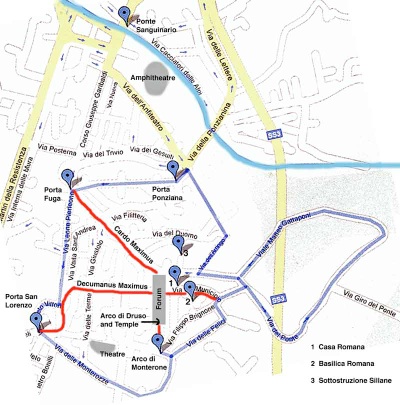
Roman Monuments in Walk I
The following Roman monuments are in Walk I.
Roman Forum
The Roman forum was built along a north-south axis on a terrace on the western slope of Spoletium. The remains of its paving have been found some 1.5 meters below the present street level of what is now Piazza del Mercato. This piazza is, however, much smaller than the original forum, which extended:
-
✴to the north along the length of what is now Via Palazzo dei Duchi (to the left of the Fonte di Mercato); and
-
✴to the south, along Via dell’ Arco di Druso to the Arco di Druso itself.
Roman House (1st century AD)
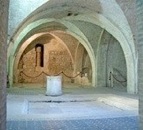
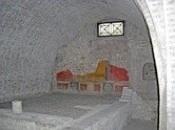
Atrium Living room
This noble house, which stood on the terrace above the forum, was excavated in 1885-1914 by Giuseppe Sordini under a building that subsequently became part of Palazzo Comunale. The house dates to the time of the Emperor Augustus and was renovated in the 2nd century AD. It is thought to have once belonged to Vespasia Polla, the mother of the Emperor Vespasian (69-79 AD).
The floor plan survives in tact, along with the remains of the mosaic floor and fragments of wall, some containing frescoes. The house had a large atrium with its main reception room (tablinum) behind it. There were bedrooms to the sides of the atrium and living rooms to the sides of the tablinum. The peristilium (inner garden) was to the left.
Roman “Basilica” (1st century AD)

The inscription, which was recorded in the 16th century, read:
Sex(tus) Volusius Sex(ti) f(ilius) Hor(atia) Melior,
IIIIvir q(uin)q(uennalis), augur, patron(us) municipi,
ob honorem IIIIviratus
Sex(ti) Volusi Noniani, fili sui,
basilicam solo publico a fundamenta
pecunia sua fecit
In this inscription, Sextus Volusius Nonianus commemorated his father, Sextus Volusius Melior, who was a member of the Horatia tribe (that of Spoleto). He was also a quattuorvir quinquennalis, an augur and a patron of the municipium. The basilica that he had financed had presumably stood on a nearby site.
Arco di Druso (23 AD)
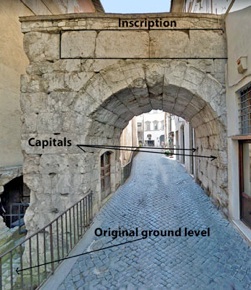
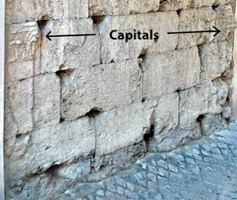
Capitals on right side
The inscription above the arch (when seen, as here, as one approached from the forum) records that the Senate of Spoleto built it in honour of Drusus and Germanicus, respectively the son and adopted son of the Emperor Tiberius. This free-standing arch provided an imposing entrance from the cardo maximus to the forum
Three of the Corinthian capitals of the inner pilasters survive. Excavations in 1955-7 lowered the level of the street on the left in order to reveal much of the original structure and a stretch of Roman paving. However, most of the stonework to the right remains encased in the adjacent buildings.
Temple (1st century AD)
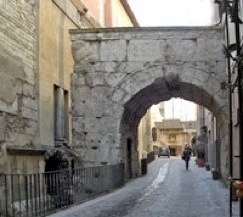

Right wall of the temple, next to Arco di Druso
with Piazza del Mercato (the forum)
behind the photographer.
Giuseppe Sordini discovered this temple under Sant' Ansano, to the left of the Arco di Druso (with Piazza del Mercato behind you) in 1900.
The temple built on a podium some 3 meters high and had a colonnade along the front and sides of an open vestibule in front of the rectangular main room. Steps from the colonnade led down into the forum.
The first church of Sant’ Ansano was built on the foundations of the temple, probably in the 9th century. The church was rebuilt with the opposite orientation in the 12th century:
-
✴its new facade was built over the original apse; and
-
✴the body of the church was extended south (i.e. back along what is now Via dell' Arco di Druso), obliterating the old facade.
The chapels that had been built in the left wall of the church were demolished in 1955-7 to reveal the remains of the right wall of the temple (illustrated above). The podium along the right side is now clearly visible, with a stretch of the original Roman paving in front of it. Part of one column from the right side of the colonnade has been inserted in its original position and the position of others has been marked out in concrete.

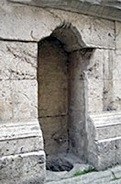
Roman Theatre (1st century BC)
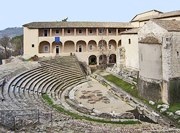
The theatre was built in local stone on an artificial terrace just inside the city wall. The earliest surviving record of the Roman theatre of Spoletium is in the form of a sketch (16th century) by Baldassarre Peruzzi. Giuseppe Sordini excavated it in 1891 and a further programme of work here was carried out in 1954-60. According to the Soprintendenza per i Beni Archeologici dell’ Umbria (in the catalogue referenced below, at p. 47):
-
“The building of the theatre is part of the programme of monumentalisation of the municipium of Spoletium carried out in the 1st century BC. The [theatre itself] was probably built immediately after the middle of the century, ...”.
The structure was badly damaged, perhaps by an earthquake, soon after its completion, when an enormous fissure opened up across the cavea (seating area). Only the left part (seen from the orchestra in the illustration above) survives: the rest, which subsided by over a meter, was rebuilt in 1954-60.

Finds from the Theatre
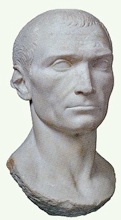
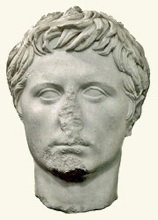
Caius Calvisius Sabinus (?) Octavian (ca. 40 BC)
A number of important artefactes that were found during the excavations of 1954-60, are now in the Museo Archeologico. They include the interesting portrait busts above
-
✴The bust on the left is sometimes said to be of Julius Caesar. However, it is more likely to portray Caius Calvisius Sabinus, who is named in an inscription from Trignano as a patron of Spoleto. He was one of only two senators who tried to protect Julius Caesar from his assassins in 44BC and was consul in 39 BC.
-
✴The important bust (ca. 40 BC) on the right, which is one of the earliest known portrait bust of Octavian (later Emperor Augustus), was newly installed in the museum in 2014, after having appeared in international exhibitions in Rome and Paris that celebrated the 2,000th anniversary of his death. This bust and a similar one at Béziers (now in the Musée Saint-Raymond, Toulouse) represent the only known images of the so-called ‘Béziers-Spoleto’ group, which Dietrich Boschung (referenced below, at pp. 25-26 and pp. 59-62) dated to 43-40 BC. (A similar bust of Octavian, which had been re-cut in ca. 315 AD as a bust of the Emperor Constantine, was discovered during excavations of the basilica forense of Volsinii/Bolsena and is now in the Museo Nazionale Etrusco, Viterbo).
Later History
The church of Sant' Agata was built over the scena (stage) of the theatre, probably in the 11th century. Some 400 Guelfs were held prisoner in what remained of the theatre in 1320-2, before being executed.
The apse of Sant’ Agata, which was probably rebuilt in the 14th century, is illustrated above. This church and Palazzo Corvi (11th century), which was built to the left of it, passed to a community of Benedictine nuns in 1395 and they built a nunnery on the site that now houses the Museo Archeologico. The architect Baldassare Peruzzi sketched the visible remains of what he recognised to be a Roman theatre in the 16th century. His annotations of the sketch in the Uffizi Gallery, Florence reveal that the remains were underground at that time, in “un monastero de moniche” (in a nunnery).
The site was used to provide building materials in the 17th and 18th centuries: this is evident, for example, in the lower part of the facade of Palazzo Ancaiani (17th century), which stands in the adjacent Piazza della Libertà. By this time, the remains were thought to have belonged to the Roman baths.
Giuseppe Sordini began the excavation of the area in 1891 on the basis of his rediscovery of Peruzzi’s sketches in Florence. Excavation was hampered by the existence of a women's prison that was built on the site in 1870. This prison was demolished in 1954 and systematic excavation was carried out in 1954-60.
Sostruzione Sillane (1st century BC)
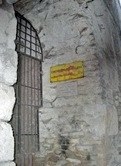
The substructure is in the form of an arched passage that runs along Via Spagna to the west and Via del Duomo to the north. The entrance in the west wing (illustrated here) is in Via Spagna. The exterior of the north wing can be seen from the courtyard of the house at 11 Via del Duomo. Professor Bruno Toscano was involved in the excavations in 1963-4, and there is a photograph of the interior of the arcade in his “L’ Umbria: Manuali per il Territorio: Spoleto”, Rome (1978) page 374.
According to tradition, the Emperor Theoderic built a palace on the terrace here in the 5th century that was later used by Lombard and Carolingian dukes. It was certainly the site of:
-
✴the Benedictine nunnery of Sant’ Eufemia, which is documented in the reign of the Emperor Otto II (973-83), and
-
✴Palazzo Vescovile, from ca. 1178.
Roman Monuments in Walk III
The following Roman monuments are in Walk III.
Roman Amphitheatre (ca. 10 AD)
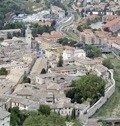
In 545 AD, the Gothic ruler Totila turned the amphitheatre into a fortress. Procopius documented this in his "De Bello Gotico": "When the Goths captured Spoletium, they razed the whole circuit of the city wall to the ground, but they walled up the entrances of [the amphitheatre] and established a garrison of both Goths and Roman (i.e. Byzantine) deserters for the purpose of guarding the surrounding countryside". The Byzantine general Belisarius captured the fortress two years later, helped by the defection of many of the "Roman deserters" back to their original allegiance.
The church of and monastery of San Gregorio Minore was built here in the 12th century.
Via dell' Anfiteatro runs parallel to the major axis of the amphitheatre. Ten open arches that formed part of its ambulatory can be seen from Caserma Minervio. [Remains of an entrance at the end of the major axis ?] [Other remains in the inner courtyard of number 16 ?]
Ponte Sanguinario (ca. 27 BC)
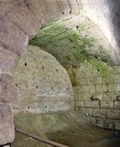
The remains of its three arches, some 8 meters high, are now below ground level. Only two of them have been excavated. The modern brick wall at the back takes the weight of the busy piazza above.
Read more:
Soprintendenza per i Beni Archeologici dell' Umbria, “Museo Archeologico di Spoleto: Spoleto: il Villaggio degli Umbri e la Città dei Romani”, (2015) Spoleto
D. Boschung, “Die Bildnisse des Augustus”, (1993) Berlin
Return to Monuments of Spoleto

